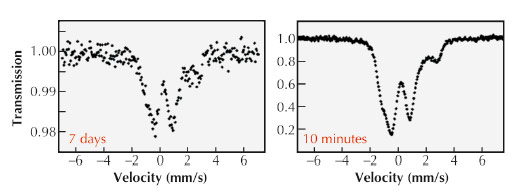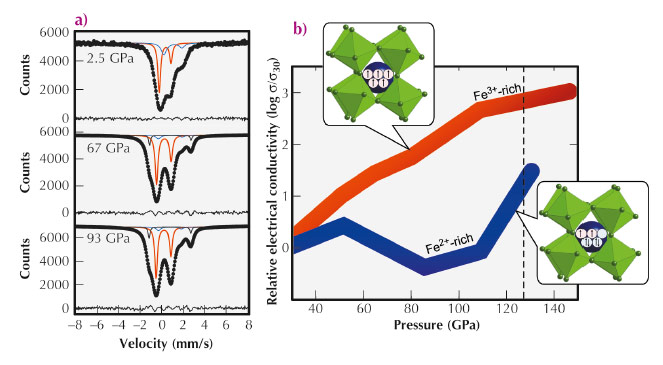- Home
- Users & Science
- Scientific Documentation
- ESRF Highlights
- ESRF Highlights 2013
- Dynamics and extreme conditions
- Iron electronic state and the electrical conductivity of the Earth’s lower mantle
Iron electronic state and the electrical conductivity of the Earth’s lower mantle
Much of our knowledge of the Earth’s interior comes from comparison of laboratory measurements of physical properties of mantle minerals with data from bulk geophysical methods. Traditionally, seismology has provided the best constraints on the internal structure of the Earth, however, electromagnetic methods can be used to construct electrical conductivity profiles, which are more sensitive to temperature and composition variations.
Iron is the most abundant element inside the Earth and variations in pressure or temperature can cause changes in the number of electrons (oxidation state) or in the distribution of electrons (spin state), which can affect electrical conductivity. The iron atoms in the Earth’s most abundant phase, (Mg,Fe)(Si,Al)O3 perovskite, are known to exist in two different oxidation states (ferrous iron and ferric iron), and both oxidation states have the possibility of undergoing a spin state transition at high pressure. Deducing the nature of iron spin transitions in (Mg,Fe)(Si,Al)O3 perovskite is challenging due to the numerous combinations of oxidation and spin state in the two crystallographic sites of its crystal structure.
To solve such problems we have developed a novel setup on ID18: a synchrotron Mössbauer source (SMS) [1] that offers a number of advantages over conventional Mössbauer spectroscopy. It has high brilliance and a nearly fully resonant emitted beam that can be focused to a spot of only a few micrometres diameter, leading to a vast improvement in signal quality for small samples (< 50 µm) (Figure 27).
 |
|
Fig. 27: Comparison of room temperature Mössbauer spectra of (Mg,Fe)(Si,Al)O3 perovskite at 93 GPa in a diamond anvil cell collected over the indicated time periods using a radioactive source (left) with one collected using the new synchrotron Mössbauer source (right). |
In this study, we used SMS spectroscopy to study the effect of pressure on the hyperfine interactions of (Mg,Fe)(Si,Al)O3 perovskite compressed and heated using a laser-heated diamond anvil cell up to pressures of 122 GPa. A representative set of SMS spectra is shown in Figure 28a. We found that no spin transition occurs in ferric iron (Fe3+) at lower mantle conditions, contrary to previous claims. Instead, ferrous iron (Fe2+) likely undergoes a partial spin transition to an intermediate spin state, suggesting that the previously observed sharp drop in electrical conductivity of (Mg,Fe)(Si,Al)O3 perovskite [2] is due to a spin transition of ferrous iron. To test this hypothesis, we measured the high-pressure high-temperature electrical conductivity of (Mg,Fe)(Si,Al)O3 perovskite containing predominantly ferric iron, and observed no drop in electrical conductivity (Figure 28b).
 |
|
Fig. 28: a) Representative room temperature Mössbauer spectra of (Mg,Fe)(Si,Al)O3 perovskite at increasing pressure. Red and blue curves are fits to the exp data, while the bottom black line is the residual. There is no evidence of a spin transition in ferric iron (Fe3+) (red doublet), whereas there is a clear pressure evolution of the signal associated with ferrous iron (Fe2+) (blue curve). b) Influence of pressure on the high-temperature electrical conductivity of (Mg,Fe)(Si,Al)O3 perovskite (red: our data; blue: ref [2]). The large drop in conductivity of the Fe2+-rich material is likely due to a partial spin transition in Fe2+ (ferrous) iron. The sketched electron configurations were inferred from the SMS spectra. |
Temperature and total iron content have previously been considered to have the greatest influence on lower-mantle electrical conductivity profiles, but our data show that the ferric to ferrous iron ratio can also affect conductivity significantly at pressures corresponding to the middle part of the lower mantle. Electrical conductivity is strongly influenced by iron oxidation and spin state and provides one more example of how small changes in electronic structure can cause large changes in physical properties, bringing us one step closer to understanding how the Earth’s internal engine works.
Principal publication and authors
V. Potapkin (a,b), C. McCammon (b), K. Glazyrin (b), A. Kantor (a,b), I. Kupenko (a,b), C. Prescher (b), R. Sinmyo (b), G.V. Smirnov (c), A.I. Chumakov (a,c), R. Rüffer (a) and L. Dubrovinsky (b), Nature Communications 4, 1427 (2013).
(a) ESRF
(b) Universität Bayreuth, Bayreuth (Germany)
(c) National Research Center ‘Kurchatov Institute’, Moscow (Russia)
References
[1] V. Potapkin, A.I. Chumakov, G. V. Smirnov, J.-P. Celse, R. Rüffer, C. McCammon and L. Dubrovinsky The 57Fe synchrotron Mössbauer source at the ESRF, J. Synchrotron Radiat. 19, 559 (2012).
[2] K. Ohta, K. Hirose, M. Ichiki, K.Shimizu, N.Sata and Y. Ohishi, Earth Planet. Sci. Lett. 289, 497 (2010).



